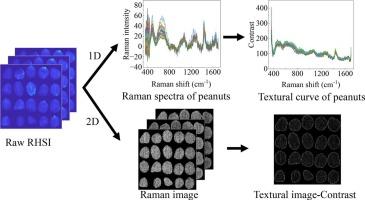Analysis of moldy peanuts by Raman hyperspectral imaging
IF 4.6
2区 化学
Q1 SPECTROSCOPY
Spectrochimica Acta Part A: Molecular and Biomolecular Spectroscopy
Pub Date : 2025-09-26
DOI:10.1016/j.saa.2025.126971
引用次数: 0
Abstract
Peanuts are susceptible to mildew which are harmful to human health. In this research, Raman hyperspectral imaging technique was used to analyze moldy peanuts of mixed varieties. One-dimensional spectral data and two-dimensional spatial information were extracted separately: spectral variable selection for the spectral data and gray-level co-occurrence matrix (GLCM) analysis for the spatial information, enabling the identification of mold-related features. Both traditional machine learning and deep learning methods were employed to train the model using the one-dimensional spectral data and two-dimensional spatial data, establishing a prediction model for moldy peanuts detection. Finally, the optimal classification model was achieved using s-GoogLeNet with one-dimensional Raman spectral data, optimized by the Adam optimizer (learning rate = 0.0005). The model demonstrated 90.25 % accuracy on the testing set, with F1 scores of 98.73 %, 96.20 %, 78.87 %, 81.16 %, 91.57 %, for the five peanut varieties (Baisha, Boke, Hongsha, Huahong, and Huayihonghuo), respectively. This research provides a powerful and innovative approach for detecting moldy peanuts of mixed varieties, which will be of great significance for improving grain safety in the industry.

花生霉变的拉曼高光谱成像分析。
花生易发霉,对人体健康有害。本研究采用拉曼高光谱成像技术对混合品种花生霉变进行了分析。对一维光谱数据和二维空间信息分别进行提取:对光谱数据进行光谱变量选择,对空间信息进行灰度共生矩阵(GLCM)分析,实现模具相关特征的识别。利用一维光谱数据和二维空间数据,结合传统的机器学习和深度学习方法对模型进行训练,建立花生霉变检测的预测模型。最后,利用s-GoogLeNet对一维拉曼光谱数据进行分类,并通过Adam优化器进行优化(学习率= 0.0005),得到最优分类模型。该模型在测试集上的准确率为90.25%,其中白沙、博克、红沙、花红、花红火5个花生品种的F1得分分别为98.73%、96.20%、78.87%、81.16%、91.57%。本研究为混合品种霉变花生的检测提供了一种强有力的创新方法,对提高行业粮食安全具有重要意义。
本文章由计算机程序翻译,如有差异,请以英文原文为准。
求助全文
约1分钟内获得全文
求助全文
来源期刊
CiteScore
8.40
自引率
11.40%
发文量
1364
审稿时长
40 days
期刊介绍:
Spectrochimica Acta, Part A: Molecular and Biomolecular Spectroscopy (SAA) is an interdisciplinary journal which spans from basic to applied aspects of optical spectroscopy in chemistry, medicine, biology, and materials science.
The journal publishes original scientific papers that feature high-quality spectroscopic data and analysis. From the broad range of optical spectroscopies, the emphasis is on electronic, vibrational or rotational spectra of molecules, rather than on spectroscopy based on magnetic moments.
Criteria for publication in SAA are novelty, uniqueness, and outstanding quality. Routine applications of spectroscopic techniques and computational methods are not appropriate.
Topics of particular interest of Spectrochimica Acta Part A include, but are not limited to:
Spectroscopy and dynamics of bioanalytical, biomedical, environmental, and atmospheric sciences,
Novel experimental techniques or instrumentation for molecular spectroscopy,
Novel theoretical and computational methods,
Novel applications in photochemistry and photobiology,
Novel interpretational approaches as well as advances in data analysis based on electronic or vibrational spectroscopy.

 求助内容:
求助内容: 应助结果提醒方式:
应助结果提醒方式:


